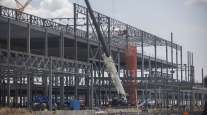Supply Chain Pressures Soar to a Record, Index Shows

[Stay on top of transportation news: Get TTNews in your inbox.]
A measure of U.S. supply chain pressures rose to a record, adding to already stiff inflationary headwinds from logistics amid dwindling warehouse space and unprecedented inventory costs.
The Logistics Managers’ Index, released April 5, advanced for a third straight month in March, reaching 76.2 from 75.2 in February. The monthly survey, released by Colorado State University and affiliated with four other American universities, asks logistics managers about inventories, warehousing and transportation.
“Continued inventory congestion has driven inventory costs, warehousing prices and overall aggregate logistics costs to all-time high levels,” the report stated. “This is putting even more pressure on already-constrained capacity.”
Inventory levels dipped to 75.7 from February’s high of 80.2, though their costs rose to a record 91, according to the report. Warehouse capacity suffered “a rather precipitous drop” in March, pushing prices for storage space to an all-time peak of 90.5.
The report highlighted crosscurrents buffeting the U.S. economy, in which accelerating inflation threatens to hurt consumer demand. Firms that boosted stockpiles during two years of pandemic-driven supply uncertainty, meanwhile, are trying to assess whether they have overbought or whether the added cushion is a more permanent feature.
Inventory costs “are anticipated to remain very high throughout the next 12 months,” according to the report. Some respondents “expect to hold a lot of inventory in the next year, and to pay a significant amount to do so.”
Some survey respondents saw more inventory growth than others as goods “continue to trickle into the U.S. but are finding less consumer interest than anticipated,” the researchers said. One explanation “is that the continued fears about inflation may have led firms to build inventories as a hedge against higher future costs.”
It is possible, they said, that recent supply chain challenges “taught manufacturers, suppliers, retailers and customers that holding inventory provides an important element of safety in uncertain times.”
In the survey results, transportation prices were little changed from a month earlier, utilization rose and capacity edged higher — perhaps not yet reflecting signs of weakness elsewhere in the second half of March that some analysts say portends a freight recession.
While that’s possible, “there’s also a good chance it could lead to a moderation in prices that could end up being a relief in some sectors of the economy,” Zac Rogers, an assistant professor of supply chain management at Colorado State, said in an email.
The transport sector is “at a much stronger place in terms of supply and demand relative to the last freight recession we saw in 2019,” he said. “With capacity as short as it has been over the last 18 months, it would take a lot to get to the point where supply is really outstripping demand.”
Still, diesel fuel prices that are about 64% higher than a year ago could cloud the outlook in transportation if they stay there for an extended period, Rogers added.
— With assistance from Bryce Baschuk and Jack Wittels.
Want more news? Listen to today's daily briefing below or go here for more info:




